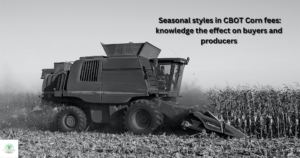 |
| Seasonal styles in CBOT Corn prices: Understand their impact on both buyers and producers in the agricultural market. |
Seasonal styles in CBOT Corn fees:
knowledge the effect on buyers and producers
Corn futures contracts traded at the Chicago Board of exchange (CBOT) play a vital role
inside the agricultural commodities marketplace. The prices of those contracts,
called C bot corn prices, are stimulated by different factors, which includes
supply and demand, climate situations, government regulations, and worldwide
monetary factors. Know-how the recurring seasonal patterns in CBOT corn prices
is vital for traders and manufacturers to make knowledgeable selections and
control fee dangers successfully
Creation to CBOT Corn fees
C bot corn charges serve as a benchmark for the corn market, imparting a reference point
for physical transactions and shaping market sentiment. Corn, also known as
maize, is a widely grown and consumed grain with applications in animal feed,
food manufacturing, and biofuel production.
The CBOT gives standardized corn futures contracts, permitting marketplace contributors to shop for or sell corn
at a predetermined price for future shipping. These contracts enable
stakeholders, including farmers, grain buyers, and speculators, to hedge in
opposition to charge volatility or speculate on future charge movements.
Factors Affecting CBOT Corn fees
Numerous factors affect CBOT corn fees, impacting the stability between supply and
demand. These elements encompass:
Deliver and demand
The essential dating among corn supply and demand is a number one motive force of
costs. Imbalances between deliver and call for can result in big charge
fluctuations. Factors inclusive of crop yields, stock ranges, and consumption
patterns play an essential function in determining the deliver-demand
stability.
Climate situations
Corn is highly sensitive to climate situations during planting, boom, and harvest
periods. Unfavorable weather activities, consisting of droughts, floods, or
extreme temperatures, can disrupt crop manufacturing and have a right away
effect on charges. Monitoring climate forecasts and information their capacity
effect on corn production is vital for investors and producers.
Government regulations
Government guidelines, consisting of subsidies, price lists, import/export regulations,
and biofuel mandates, can affect corn charges. For example, regulations selling
ethanol manufacturing can increase corn demand and eventually impact charges.
Understanding authorities policies and their implications is important
for assessing fee developments.
Worldwide economic elements
Tendencies within the international economic system, change fees, and geopolitical events
can affect corn fees. Economic increase, profits tiers, and exchange
relationships among nations all effect corn call for and fees. Traders and
producers need to live knowledgeable approximately worldwide monetary factors
that may have an effect on CBOT corn prices.
Geopolitical occasions
Geopolitical activities, including conflicts or political instability, can disrupt corn
manufacturing and impact charges. Traders and producers ought to live informed
approximately geopolitical trends that can affect corn deliver and call for
globally.
Agricultural marketplace studies corporations provide in-intensity analysis, reviews, and
forecasts on the corn marketplace. Investors and producers can leverage those
sources to gain insights into charge trends, supply-call for dynamics, and
other factors influencing CBOT corn costs.
The impact of Seasonal styles on CBOT Corn charges
CBOT corn prices exhibit habitual seasonal styles encouraged by different factors throughout
the 12 months. Knowledge these styles is vital for buyers and manufacturers to
make informed selections. Let’s explore the effect of seasonal patterns in one
of a kind stages of corn production.
 |
| CBOT Corn fees can be affected by economic indicators, such as inflation rates and currency exchange rates, which impact the cost of production and transportation. |
Planting Season
The planting season, normally within the spring, sets the foundation for corn manufacturing.
In the course of this era, farmers decide their planting intentions primarily
based on factors which include expected charges, weather outlooks, and input
costs. The anticipation of planting selections and weather situations can cause
charge actions in CBOT corn contracts. Investors and manufacturers have to
intently screen historical planting season patterns to pick out capacity fee
trends.
Developing Season
The developing season, from planting to maturity, is a critical segment for corn
production. Climate situations, which includes rainfall, temperature, and
sunlight, extensively effect crop improvement and yield capability. Damaging
weather activities, consisting of droughts or immoderate rainfall, can
negatively affect corn expenses. Investors and manufacturers need to examine
ancient developing season styles and live up to date with weather forecasts to
assume capacity rate actions.
Harvest Season
The harvest season marks the fruits of corn manufacturing, and the timing and extent of
harvest can effect expenses. Because the transport of corn will increase at
some point of this period, charges may additionally revel in downward pressure.
But, surprising weather occasions or behind schedule harvests can disrupt
deliver and lead to charge volatility. Analyzing historic harvest season styles
and tracking real-time harvest development is critical for investors and
manufacturers.
Strategies for investors and producers to Navigate Seasonal patterns
Navigating seasonal styles in CBOT corn expenses calls for a proactive method and the
usage of numerous strategies. Right here are some key strategies for traders
and manufacturers.
Utilizing ancient data
Studying
ancient statistics on seasonal fee moves can offer teased insights into
ordinary styles. Buyers and manufacturers can pick out traits, seasonality, and
potential rate tiers based totally on historic records. This information can
manual selection-making and chance management techniques.
Tracking weather Forecasts
Climate forecasts play an essential function in expecting capability rate moves.
Traders and manufacturers have to closely monitor climate forecasts during the
planting, growing, and harvest seasons to evaluate the capacity effect on corn
manufacturing and expenses. Timely changes to trading and manufacturing
strategies can be made based on climate outlooks.
Expertise government rules
Government regulations, which includes subsidies, change agreements, and biofuel mandates,
can drastically impact corn expenses. Investors and producers need to live
updated on applicable policy changes and verify their potential implications
for corn supply and call for. This information can help expect charge moves and
adjust buying and selling or manufacturing strategies thus.
Case research: studying ancient Seasonal patterns
Analyzing historic seasonal styles can offer valuable insights into fee actions during
different degrees of corn manufacturing. Let’s discover a few case studies to
recognize the effect of seasonal styles on CBOT corn fees.
Seasonal fee actions in Planting Season
Ancient facts evaluation famous that planting season patterns regularly exhibit fee
moves inspired with the aid of factors such as planting intentions, climate
outlooks, and market sentiment. Investors and manufacturers can examine these
patterns to pick out capability price tendencies and regulate their techniques
as a consequence.
Seasonal rate actions in developing Season
All through the growing season, weather situations play a massive function in corn
manufacturing and subsequent rate moves. Ancient analysis of developing season
styles can help traders and manufacturers count on ability fee volatility and
take appropriate danger management measures.
Seasonal price actions in Harvest Season
The harvest season brings extended corn deliver to the marketplace. Ancient analysis of
harvest season patterns can help traders and producers apprehend charge
tendencies all through this period. Monitoring actual-time harvest development
and capability disruptions can aid in making informed choices.
Hazard management techniques for investors and producers
Dealing with fee dangers is important for buyers and producers running within the CBOT corn
market. Right here are some chance management techniques to don’t forget:
Hedging with Futures Contracts
Investors and producers can hedge against charge volatility by utilizing corn futures
contracts. By means of taking an offsetting function inside the futures market,
they are able to protect themselves from destructive charge movements. Hedging
lets in for fee stability and threat mitigation.
Alternatives techniques
Alternatives contracts provide traders and manufacturers with additional flexibility in
managing charge dangers. By using buying or selling options, they can
restriction downside risk whilst maintaining the potential for upside gains.
Knowledge options strategies and their implications is essential for effective
danger control.
Diversification
Diversifying hazard by undertaking multiple agricultural commodities can help buyers and
producers reduce their exposure to charge fluctuations. By way of spreading
investments across one-of-a-kind commodities, they can mitigate the effect of
any unmarried commodity’s seasonal styles on their average portfolio.
The function of global factors in Seasonal styles
Global elements, which includes worldwide trade dynamics, alternate costs, and
geopolitical occasions, can have an impact on seasonal patterns in CBOT corn
costs. Traders and producers ought to remember the following:
International alternate Dynamics
Adjustments in trade guidelines, market get admission to, and export call for can effect
CBOT corn fees. Traders and producers need to stay updated on international
trade dynamics, inclusive of alternate agreements and price lists, to count on
ability fee moves.
Exchange fees
Fluctuations in alternate charges can have an effect on the competitiveness of corn exports
and imports. Investors and manufacturers involved in global corn alternate must
display exchange charge movements to evaluate their impact on CBOT corn prices.
Geopolitical occasions
Geopolitical
activities, including conflicts or political instability, can disrupt corn
manufacturing and impact charges. Traders and producers ought to live informed
approximately geopolitical trends that can affect corn deliver and call for
globally.
Equipment and sources for tracking CBOT Corn fees
Get right of entry to dependable records is important for buyers and producers to monitor
CBOT corn prices efficiently. Here are some gear and assets:
Financial news websites
Economic news web sites offer actual-time updates on CBOT corn charges, marketplace
evaluation, and applicable news articles. Buyers and producers can live
informed approximately rate actions and elements influencing the corn
marketplace via those platforms.
Commodity marketplace platforms
Commodity market systems offer get right of entry to CBOT corn price facts, ancient
charts, and trading functionalities. Traders can examine rate tendencies, song
marketplace sentiment, and execute buying and selling techniques the usage of
those structures.
Agricultural marketplace studies firms
Agricultural marketplace studies corporations provide in-intensity analysis, reviews, and
forecasts on the corn marketplace. Investors and producers can leverage those
sources to gain insights into charge trends, supply-call for dynamics, and
other factors influencing CBOT corn costs.
Conclusion:
Navigating Seasonal styles for achievement in CBOT Corn trading
corn charges is critical for investors and manufacturers to make knowledgeable
choices and control fee dangers successfully. By way of analyzing historic
data, tracking weather forecasts, and staying updated on government rules and
worldwide elements, traders and producers can navigate seasonal patterns and
optimize their buying and selling and production techniques. With the proper
tools and resources, buyers and manufacturers can obtain fulfillment in CBOT
corn buying and selling whilst minimizing dangers associated with seasonal rate
movements.




